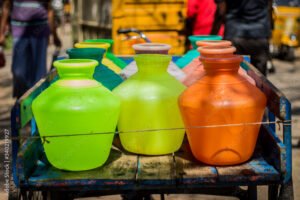Peruvian Cuisine: A Journey Through the Flavors of Peru’s Diverse Culinary Landscape

Peruvian cuisine has rapidly risen to global prominence, becoming a favorite for food enthusiasts around the world. Known for its rich diversity, deep-rooted traditions, and fusion of indigenous and international influences, Peruvian food reflects the country’s unique geography and history. Stretching from the Pacific coast to the Andes mountains and the Amazon rainforest, Peru’s culinary offerings are as varied as its landscapes, each region contributing distinctive ingredients and flavors. In this article, we will explore the history, key ingredients, and some of the most iconic dishes that define Peruvian food.
A Blend of History and Cultures
Table of Contents
TogglePeruvian cuisine’s depth is deeply tied to its cultural and historical context. Before the arrival of Spanish colonizers in the 16th century, the Inca Empire and other Andean cultures had already developed sophisticated agricultural techniques. Staples like potatoes, maize, quinoa, and a wide range of legumes were central to their diet. Peru is home to over 4,000 varieties of potatoes, and it’s where quinoa originated, making these two ingredients a foundational part of the local cuisine.
When the Spanish arrived, they introduced new ingredients such as cattle, pigs, chickens, wheat, and dairy products, further expanding the scope of Peruvian food. But the real explosion of flavors happened in the 19th and 20th centuries, as waves of immigrants from China, Japan, and Africa added their own culinary traditions to the mix. This fusion of influences from Europe, Asia, and Africa created a culinary melting pot that makes Peruvian cuisine so dynamic today.
Key Ingredients of Peruvian Cuisine
The ingredients that define Peruvian food reflect the country’s rich biodiversity. From the cold waters of the Pacific Ocean to the fertile Andean highlands, here are some of the most important staples in Peruvian cooking:
1. Potatoes
As the birthplace of the potato, Peru takes pride in this humble tuber. With over 4,000 native varieties, the potato plays a key role in many traditional dishes. It is prepared in numerous ways—boiled, baked, fried, or mashed. Dishes like papa a la huancaína (potatoes in spicy cheese sauce) and causa rellena (a layered potato dish filled with ingredients like chicken or tuna) highlight the versatility of potatoes in Peruvian cuisine.
2. Quinoa
Quinoa, often regarded as a superfood, has been cultivated in Peru for thousands of years. This high-protein grain is a staple in many Peruvian households and is used in a variety of dishes, from soups to salads. Today, quinoa’s global popularity has brought attention to its nutritional value and its central role in traditional Andean diets.
3. Ají Peppers
Ají peppers are the heart and soul of Peruvian cooking. The ají amarillo (yellow chili pepper) is the most iconic, offering a fruity, medium-heat flavor that enhances many sauces and stews. Other varieties like rocoto and ají panca also add depth and spice to dishes. Ají peppers are often used in salsas, marinades, and popular dishes like ají de gallina, a creamy chicken stew.
4. Seafood
Peru’s long coastline provides access to fresh, high-quality seafood, making it a cornerstone of coastal Peruvian cuisine. One of the most famous dishes is ceviche, made with raw fish marinated in lime juice, mixed with onions, cilantro, and ají peppers. The acidity of the lime juice “cooks” the fish, creating a refreshing and flavorful dish that is beloved across the country.
5. Corn (Maíz)
Corn, or maíz, is another essential ingredient in Peruvian cooking. With numerous varieties, including choclo (large-kernel corn), corn is used in snacks, drinks like chicha morada (a sweet, purple corn-based drink), and side dishes like cancha, a popular roasted corn snack.
Iconic Dishes of Peruvian Cuisine
The richness of Peruvian cuisine is best expressed through its iconic dishes, each one telling a story of the country’s history and cultural influences.
1. Ceviche
As Peru’s national dish, ceviche holds a special place in the hearts of Peruvians and food lovers worldwide. This dish, typically made with fresh white fish marinated in lime juice, is often served with sides of corn, sweet potatoes, and onions. The simplicity and freshness of ceviche have made it an international favorite, but its roots in coastal Peruvian culture remain strong.
2. Lomo Saltado
Lomo saltado is a prime example of Peru’s fusion cuisine, combining Chinese stir-fry techniques with traditional Peruvian ingredients. This dish consists of marinated strips of beef sautéed with onions, tomatoes, and ají peppers, and is usually served with both rice and French fries. It’s a beloved comfort food that highlights the influence of Chinese immigrants on Peruvian cooking.
3. Aji de Gallina
Aji de gallina is a creamy, mildly spicy chicken stew made with shredded chicken, ají amarillo, bread, milk, and cheese. It is typically served with boiled potatoes and rice, offering a hearty and satisfying meal. This dish is a fusion of indigenous ingredients with European techniques, reflecting the blend of cultures in Peru.
4. Causa Rellena
This colorful, layered dish is made from mashed yellow potatoes seasoned with lime and ají, and filled with ingredients like chicken, tuna, or avocado. Causa rellena is often served cold as an appetizer and is popular for its bright flavors and beautiful presentation.
5. Anticuchos
Anticuchos are skewers of marinated and grilled meat, most commonly made with beef heart. This dish is a favorite street food in Peru, often served with boiled potatoes and corn. The marination, using vinegar, garlic, and ají, gives the meat a rich, smoky flavor, making it a must-try for any visitor.
The Global Rise of Peruvian Cuisine
In recent decades, Peruvian cuisine has taken the global stage, with chefs like Gastón Acurio, Virgilio Martínez, and Mitsuharu Tsumura bringing attention to Peru’s rich culinary heritage. Lima, Peru’s capital, is now considered one of the top food cities in the world, home to restaurants like Central and Maido, which consistently rank among the best globally.
Peru’s embrace of its indigenous ingredients, combined with its openness to international influences, has made it a culinary destination for food adventurers. From street food vendors to fine dining establishments, Peruvian food is both accessible and innovative, offering a unique blend of tradition and creativity.
Conclusion
Peruvian cuisine is a vibrant reflection of the country’s history, geography, and cultural diversity. With its rich array of ingredients, from the Andean highlands to the Pacific coast, and its fusion of flavors from indigenous, Spanish, African, Chinese, and Japanese influences, Peruvian food offers something for everyone. Whether you’re enjoying a plate of ceviche by the coast or indulging in the comforting flavors of aji de gallina, Peruvian cuisine promises an unforgettable culinary journey. As the world continues to discover and celebrate the wonders of Peruvian food, its flavors will only grow in popularity, enriching global palates for years to come.













Post Comment